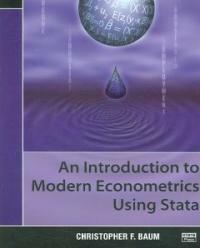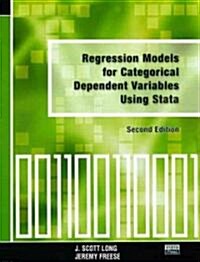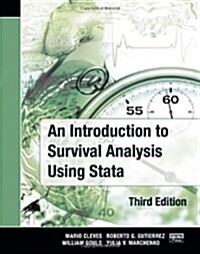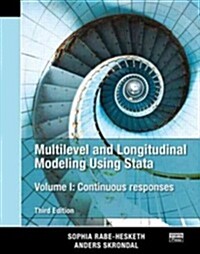
An introduction to modern econometrics using Stata
- 발행사항
- College Station, Tex: Stata Press, 2006
- 형태사항
- xviii, 341 p. : ill; 24cm
- ISBN
- 9781597180139
- 청구기호
- 413.8 B347a
- 서지주기
- Includes bibliographical references (p. [321]-327) and indexes
소장정보
| 위치 | 등록번호 | 청구기호 / 출력 | 상태 | 반납예정일 |
|---|---|---|---|---|
이용 가능 (1) | ||||
| 1자료실 | 00015094 | 대출가능 | - | |
- 등록번호
- 00015094
- 상태/반납예정일
- 대출가능
- -
- 위치/청구기호(출력)
- 1자료실
책 소개
As an expert in Stata, the author successfully guides readers from the basic elements of Stata to the core econometric topics. He first describes the fundamental components needed to effectively use Stata. The book then covers the multiple linear regression model, linear and nonlinear Wald tests, constrained least-squares estimation, Lagrange multiplier tests, and hypothesis testing of nonnested models. Subsequent chapters center on the consequences of failures of the linear regression model's assumptions. The book also examines indicator variables, interaction effects, weak instruments, underidentification, and generalized method-of-moments estimation. The final chapters introduce panel-data analysis and discrete- and limited-dependent variables and the two appendices discuss how to import data into Stata and Stata programming.
Presenting many of the econometric theories used in modern empirical research, this introduction illustrates how to apply these concepts using Stata. The book serves both as a supplementary text for undergraduate and graduate students and as a clear guide for economists and financial analysts.
Integrating a contemporary approach to econometrics with the powerful computational tools offered by Stata, this introduction illustrates how to apply econometric theories used in modern empirical research using Stata. The author emphasizes the role of method-of-moments estimators, hypothesis testing, and specification analysis and provides practical examples that show how to apply the theories to real data sets. The book first builds familiarity with the basic skills needed to work with econometric data in Stata before delving into the core topics, which range from the multiple linear regression model to instrumental-variables estimation.
목차
PREFACE
NOTATION AND TYPOGRAPHY
INTRODUCTION
An Overview of Stata's Distinctive Features
Installing the Necessary Software
Installing the Support Materials
WORKING WITH ECONOMIC AND FINANCIAL DATA IN STATA
The Basics
Common Data Transformations
ORGANIZING AND HANDLING ECONOMIC DATA
Cross-Sectional Data and Identifier Variables
Time-Series Data
Pooled Cross-Sectional Time-Series Data
Panel Data
Tools for Manipulating Panel Data
Combining Cross-Sectional and Time-Series Datasets
Creating Long-Format Datasets with Append
The Reshape Command
Using Stata for Reproducible Research
LINEAR REGRESSION
Introduction
Computing Linear Regression Estimates
Interpreting Regression Estimates
Presenting Regression Estimates
Hypothesis Tests, Linear Restrictions, and Constrained Least Squares
Computing Residuals and Predicted Values
Computing Marginal Effects
Appendix A: Regression as a Least-Squares Estimator
Appendix B: The Large-Sample VCE for Linear Regression
SPECIFYING THE FUNCTIONAL FORM
Introduction
Specification Error
Endogeneity and Measurement Error
REGRESSION WITH NON-I.I.D. ERRORS
The Generalized Linear Regression Model
Heteroskedasticity in the Error Distribution
Serial Correlation in the Error Distribution
REGRESSION WITH INDICATOR VARIABLES
Testing for Significance of a Qualitative Factor
Regression with Qualitative and Quantitative Factors
Seasonal Adjustment with Indicator Variables
Testing for Structural Stability and Structural Change
INSTRUMENTAL-VARIABLES ESTIMATORS
Introduction
Endogeneity in Economic Relationships
2SLS
The ivreg Command
Identification and Tests of Overidentifying Restrictions
Computing IV Estimates
ivreg2 and GMM Estimation
Testing and Overidentifying Restrictions in GMM
Testing for Heteroskedasticity in the IV Context
Testing the Relevance of Instruments
Durbin-Wu-Hausman Tests for Endogeneity in IV Estimation
Appendix A: Omitted-Variables Bias
Appendix B: Measurement Error
PANEL-DATA MODELS
FE and RE Models
IV Models for Panel Data
Dynamic Panel-Data Models
Seemingly Unrelated Regression Models
Moving-Window Regression Estimates
MODELS OF DISCRETE AND LIMITED DEPENDENT VARIABLES
Binomial Logit and Probit Models
Ordered Logit and Probit Models
Truncated Regression and Tobit Models
Incidental Truncation and Sample-Selection Models
Bivariate Probit and Probit with Selection
APPENDIX A: GETTING THE DATA INTO STATA
Inputting Data from ASCII Text Files and Spreadsheets
Importing Data from Other Package Formats
APPENDIX B: THE BASICS OF STATA PROGRAMMING
Local and Global Macros
Scalars
Loop Constructs
Matrices
return and ereturn
The Program and Syntax Statements
Using Mata Functions in Stata Programs
REFERENCES
AUTHOR INDEX
SUBJECT INDEX





